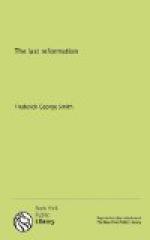--------------- FOURTH | REIGN OF THE | | CHRIST’S KINGDOM BEAST | “LITTLE HORN” | | TRIUMPHANT Dan. 9:7, 23, | Dan. 7:8, 20-25 | | Dan. 7:26, 27; 24 | | | 2:34, 35 ----------------+---------------------+----------------+----
---------------
[Sidenote: Great Babylon]
A more particular description of the antitypical Babylon is given by the Revelator in the seventeenth chapter, as follows: “And there came one of the seven angels which had the seven vials, and talked with me, saying unto me, Come hither; I will show unto thee the judgment of the great whore that sitteth upon many waters: with whom the kings of the earth have committed fornication, and the inhabitants of the earth have been made drunk with the wine of her fornication. So he carried me away in the spirit into the wilderness: and I saw a woman sit upon a scarlet-colored beast, full of names of blasphemy, having seven heads and ten horns. And the woman was arrayed in purple and scarlet color, and decked with gold and precious stones and pearls, having a golden cup in her hand full of abominations and filthiness of her fornication: and upon her forehead was a name written, MYSTERY, BABYLON THE GREAT, THE MOTHER OF HARLOTS AND ABOMINATIONS OF THE EARTH. And I saw a woman drunken with the blood of the saints, and with the blood of the martyrs of Jesus: and when I saw her, I wondered with great admiration” (verses 1-6).
The careful student will immediately perceive that we have here another representation of the same apostate powers already described under other symbols. The leading figures—a woman and a beast—combine symbols from human life and animal life, thus representing clearly the union of civil and ecclesiastical power. The combination is exactly the same in its essential characteristics as that presented by the first beast of Revelation 13. And since it is the same seven-headed and ten-horned beast, representing the same political power, we conclude that the human characteristics exhibited in this connection symbolize the same religious power—the Church of Rome. In the present vision, however, the ecclesiastical phase is singled out and particularly distinguished and described, thus placing special emphasis on the papal church itself in contradistinction to the temporal power of the empire. The political phase of Rome’s history has already been sufficiently described for our present purpose. We shall, therefore, devote our attention to the ecclesiastical phase as developed under this particular symbol of the woman.




